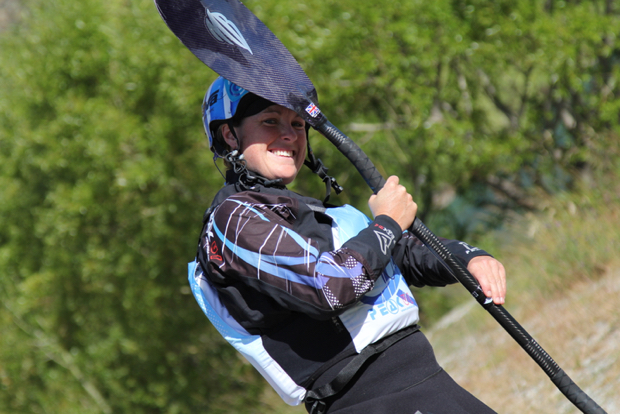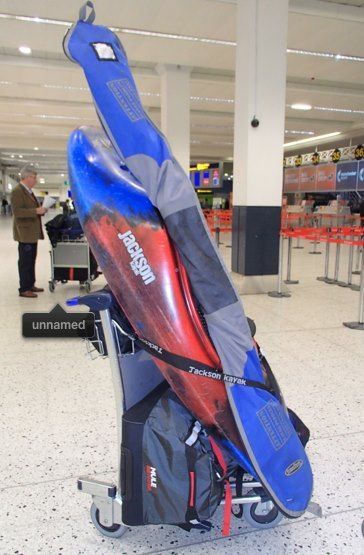Top tips for getting a kayak on a plane and the top 7 kayak friendly airlines

Claire O'hara | http://www.claireohara.co.uk - Ever had butterfly's on the drive to your paddling destination. Boat and gear loaded in the car. You know whats in store. Your totally prepared but will it work? Will you get through it ok? Today your not driving to a new rapid, river, big drop or wave. Today your driving to the airport and your nerve wracking challenge and line of choice is to make it through the check in desk, past the agent and make it safely to your next paddling destination with all of your money and gear.
Having spent the last 3 years travelling full time and the 10 years plus before that travelling regularly to kayak I thought its time for me to throw down my top 10 tips and random pieces of advice on how to travel quickly, easily and relatively stress free with a kayak.
My Top 7 Kayak Friendly Airlines: Virgin Atlantic, Emirates, Ethiad, South West, Virgin Australia, Air NZ & Jet Blue
TOP TIPS
1. Be prepared
Research your airlines and airports and try where possible to fly with kayak friendly or at least a sports equipment friendly airline. Know their prices, rules and dimensions well. Be prepared to print the policy or have it handy on your phone so you can hand it over to them to make things easier for them and save them time. When you arrive to a check out worker who has no idea what there kayak baggage policy or surf equipment policy is you want to make sure everything you say matches with what they will read / find on the screens. Know it well and don't lie as they will stick to what it says on their rules especially if your in a massive check in line. Make sure you read the small print when you do your research as even some of the kayak friendly airlines don't fly sports equipment certain flight paths or planes. Even if they normally charge you it doesn't mean it will go on every flight. e.g US airways and US Express flights
 2. Wrap it well
2. Wrap it well
There are two reasons to wrap a kayak well.
To disguise it
If it is a kayak friendly airline you have no need to worry about disguising your boat you just need to protect it. But if its a anti kayak airline then you'll need to put it in a non branded or logo'd bag and make sure your not wearing a t-shirt with kayaking written all over it. You can easily disguise a kayak as oversized luggage or another type of sports equipment. A lot of airlines will take river surf equipment or even if your Bren Orton a disabled water ski but often not a kayak!!!
To protect it
I have personally been told by senior management of certain airlines that they no longer fly kayaks due to too many damage claims. So my advice is to wrap your kayak well so it has the least chance of damage and therefore causes the least amount of stress to both you and the airline. If you can, try make some sort of handles so its easier for the baggage handler to carry it and move it around.
All that said if they are a kayak friendly airline and especially if they take a weight not piece allowance e.g Emirates, Ethiad. I have found kayaks are least like to get damaged if you leave them empty and not wrapped up in a bag (note: this doesn't apply to carbon boats) and just take your gear in a separate bag. Then they can be easily carried and moved around and baggage handlers have a much better idea of how to treat them. If you think about it its way easier for us to move a kayak empty than it is fully loaded and in a bag and we actually care about looking after them!!!
3. Stick within the weight allowance
Try where possible to stick within your kayak / sports equipment baggage allowance. Sometimes its tempting to fully overload your boat with gear. This can work but can also make the check out person more doubtful about accepting the boat or more likely to charge you more. Also the heavier the boat the more chance of damage as it will be harder for the baggage handlers to move around.
That said I have seen friends get a 35kg boat on as 23kg boats with a well placed toe wedged under the boat to take the weight of the scale. Or when travelling with a big group we have weighed in the empty boats first and left the heavy over weight boats too last hoping that the check out staff gets bored and don't weigh them all. I have also seen this back fire and extra charges been used.
I have also seen super lightweight (fragile) squirt boats been thrown from the cargo door off a plane. There seems to be an exception to every rule!
4. Paddles
Cough, cough cough. We don't travel with kayaks and paddles. 90% of the time I travel with river surf equipment and skis ;) Again if its a kayak friendly airline then no worries its kayaks and paddles for sure. Especially if its a by weight allowance, rather than by piece. Put them in a paddle bag and pad them out well with towels, t-shirts or other clothes. But if its not a kayak friendly airline then put them on as skis. Pretty much every airline has a pretty good ski baggage policy and check out staff are much more familiar with them.
I've travelled a few times with just paddles and a helmet and borrowed / rented boats and gear. This has worked really well if i'm travelling too destinations that have airports only served by bad anti kayak or super expensive sports equipment airlines but that are ok with oversized baggage and are ski friendly e.g. Air Canada, Delta and KLM.
My other top tips for travelling with paddles are:
Travel with splits / break downs that way you can have one or two sets securely taped on the inside of your boat, which should mean there's much less risk of them getting lost or broken.
If you are travelling as a group put all the paddles in one paddle bag (ski bag ;)) together and that way it only counts as one extra item and you can split any additional baggage charge / bills between you.
 5. Arrive early
5. Arrive early
There is nothing more difficult than trying to explain what a kayak is and why it should be allowed on the plane, without you being charged an excessive amount of extra excess fees, to a check in staff member who is stressing about the plane leaving when there is still a massive line. I have found that if you arrive early and cause as little inconvenience as possible you have a much easier time getting through. Also the earlier you are the less likely the staff are to already have been stressed out and annoyed by other holiday makers meaning you get to be awkward customer number one.
6. Smile
Following on from point 1 & 5. Smile, be happy and friendly. It's not their airline, it's not their decision, the're just following the rules. Try and make the check in as stress free and pleasant as possible that way it won't ruin anyone's day. If it says on the baggage policy they'll take it. Then they will take it. Eventually.
7. Helmets, Sprayskirts and Knifes
I like to fly with my helmet in my carry on bag. That way I know its not getting damaged or lost. It also means I have my nose clip, earplugs etc so if my baggage does get delayed I can borrow everything else and still go paddling. I usually just clip it on the outside of my rucksack. I have had friends wear pfd's, sprayskirts and even paddling jackets onto the plane before to minimise weight. If you do this make sure you take out your river knife and check that in with your bags. If you are travelling with a full face helmet in your hand luggage don't be surprised if you are asked by the flight attendants to hand it over when you board the plane so they can secure it safely during the flight.
8. Check it, in the airport
So you've made it. You've checked in and your on your flight. Its not over yet. Make sure when (if) your bags arrive that you check your boat and paddles for damage before you leave the airport. If there is any damage and you do want to make a claim you need to register the damage before you leave. Please note back to point 2 though and only place genuine claims. Kayak friendly airlines are already becoming rare. If your claiming from the airline for damage from the river or other damage caused elsewhere on your trip then beware. You could be responsible for making kayak friendly airlines extinct!
9. Coming home
It always helps to keep any receipts, baggage tickets etc you get on your flight out to use as proof that the airline takes and has already flown your boat for your journey home or for any future flights with the same airline. It will also help with making sure you don't get over charged on your way home especially if you don't speak the local dialect in the airport your flying home from.
10. How to get the kayak through the airport. The art of airline trolley loading!!!
This is a whole other chapter in itself. My one top tip is that no matter heavy and awkward it is to carry or move around the airport. Remember that as you approach the check in desk you need to make it look easy and effortless. Remember your trying to sell that its just another normal piece of luggage no more difficult for the airline than a suitcase on wheels!
Hint: A spare roof rack / cam strap to secure it stood on its end to a trolly can really help :)
I hope this helps and I wish you every success at every check in line that you run and that all your equipment always arrives in your final eddy destination in one piece and on time.
Other tips?
You can share your experience and tips for 'flying with a boat' in the below.





